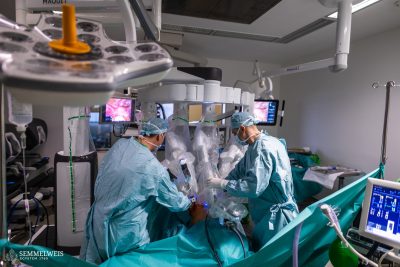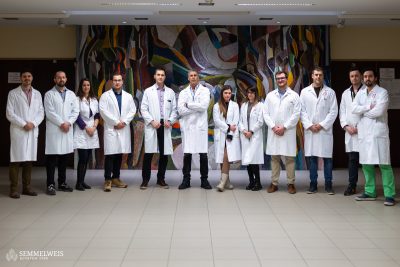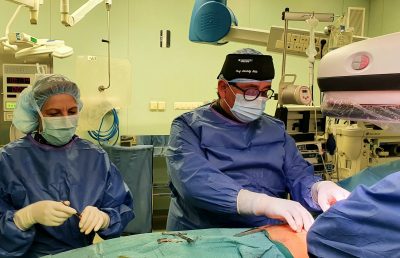Dr. Imre Sallai, a medical specialist candidate at Semmelweis University’s Department of Orthopedics, has won the university’s 2018 Innovation Award in the PhD category, for his PhD dissertation titled “The study of microvesicles in periprosthetic infections,” which was started in 2016 under the supervision of associate professor Dr. Gábor Skaliczki. The goal of the research group was to study whether microvesicles released by white blood cells quantifiably appear in periprosthetic joint infections and can be used as a diagnostic tool. In the course of their work, they have developed a completely new and standard protocol for isolating vesicles, related to which they have filed for a patent.
Around 15,000–16,000 primary hip and knee replacement surgeries are performed in Hungary each year, said Dr. Imre Sallai. One of the most problematic complications relating to joint implants is infection (occurring in 2–3% of cases), with its frequency increasing with age. The implanted prosthetics – being a foreign object in the body – provide a suitable surface for bacteria in the blood stream (even a cold or a cavity can be sources of infection) to stick to, leading to sepsis, the resident explained. He added that infections are usually caused by microorganisms creating a biofilm, which attaches to the surface of the implant and the bone cement anchoring the prosthesis, therefore the infection generally cannot be treated with antibiotics and surgical intervention is required in almost every case. The mortality rate of the revision surgery that comprises two separate operations is higher than that of breast, colon or prostate cancer, noted Dr. Gábor Skaliczki, demonstrating the significance of the research.
 Recently, the role of microvesicles has come into focus with relation to the discovery of infections, said Dr. Gábor Skaliczki, who is a member of several Hungarian and international research teams. He stressed that despite numerous studies, there is still no clear diagnostic tool today that would help to differentiate cases of prosthetic loosening by whether they are caused by infection or by so-called mechanical loosening, where it is enough to replace the loosened components.
Recently, the role of microvesicles has come into focus with relation to the discovery of infections, said Dr. Gábor Skaliczki, who is a member of several Hungarian and international research teams. He stressed that despite numerous studies, there is still no clear diagnostic tool today that would help to differentiate cases of prosthetic loosening by whether they are caused by infection or by so-called mechanical loosening, where it is enough to replace the loosened components.
Dr. Imre Sallai started his PhD studies in 2016 and has been participating in the research since then. The first results of the studies seem to indicate that the method they are using now can help diagnose the infections, said Dr. Gábor Skaliczki. Dr. Imre Sallai added that they are now working on developing a basic and comprehensive strategy, which includes observing definitely infected and uninfected materials removed from patients, and comparing them with the results gained from flow cytometric analysis. He explained that this is also necessary because it allows them to discover differences by looking at the characteristics of the two groups.
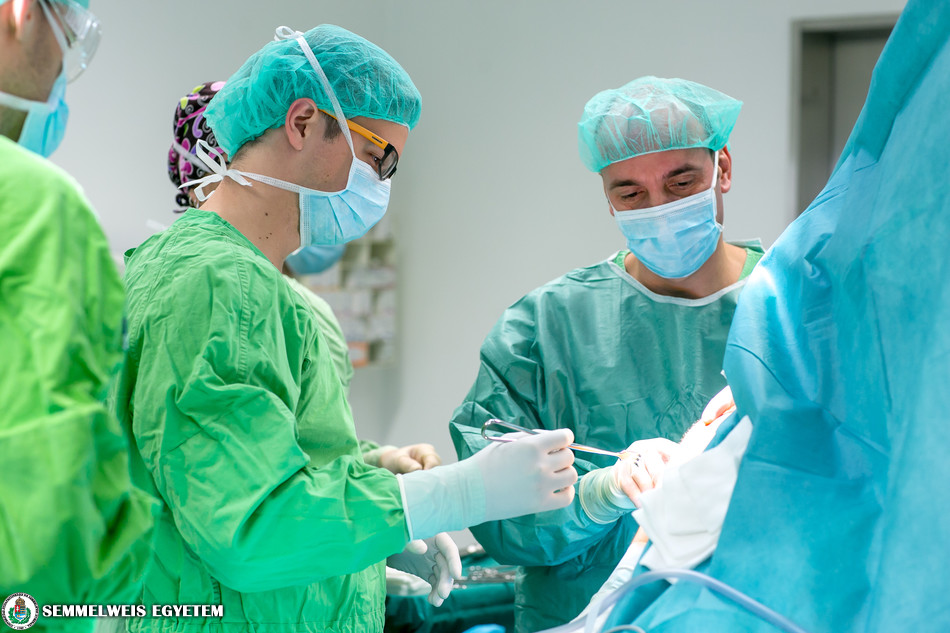 Regarding the next step in their study, Dr. Gábor Skaliczki said that they will try to find out what kind of proteins are in the microvesicles and fine-tune the methodology used so that microvesicles in periprosthetic infections can be detected faster. He declared that they have already patented the protocol for isolating vesicles, but developing the diagnostic method – which in the best scenario could be applied even at the patient’s bedside – will take at least another one or two years of work.
Regarding the next step in their study, Dr. Gábor Skaliczki said that they will try to find out what kind of proteins are in the microvesicles and fine-tune the methodology used so that microvesicles in periprosthetic infections can be detected faster. He declared that they have already patented the protocol for isolating vesicles, but developing the diagnostic method – which in the best scenario could be applied even at the patient’s bedside – will take at least another one or two years of work.
Also participating in the research in addition to the Department of Orthopedics are workers at the Department of Genetics, Cell- and Immunobiology (Dr. Edit Buzás, Dr. György Nagy, Dr. Nikolett Marton, Dr. Zsolt Komlósi), the Department of Laboratory Medicine (Dr. Barna Vásárhelyi, Dr. Katalin Kristóf), the Hungarian Academy of Sciences’ Institute of Experimental Medicine (MTA-KOKI), ELTE’s Hevesy György PhD School of Chemistry (Dr. László Drahos, Dr. Lilla Turiák), as well as the Helios ENDO-Klinik Hamburg, a European prosthetics center which is providing funding support for the work.
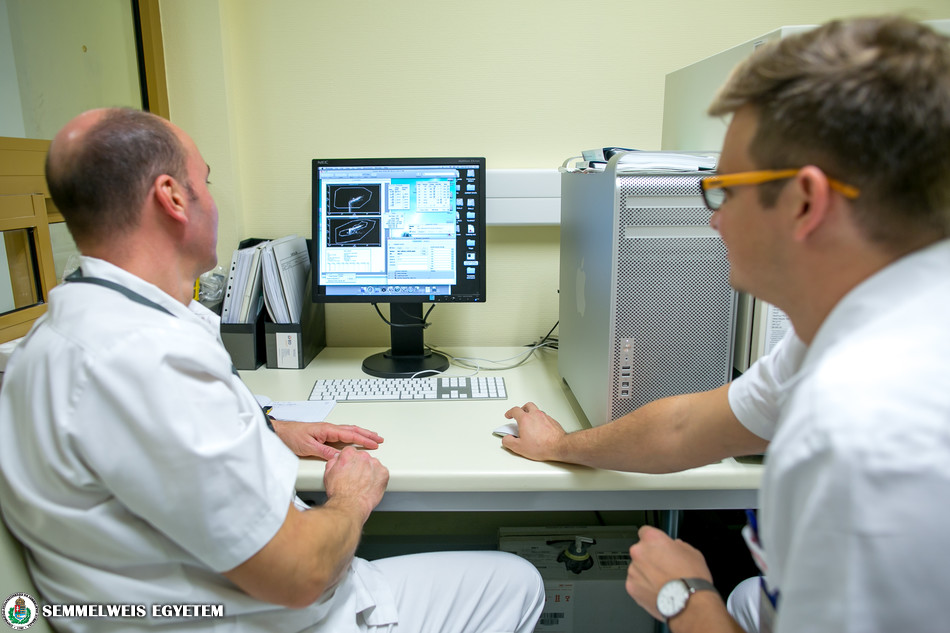 The Innovation Award-winning Dr. Imre Sallai said that his many years of work started bearing visible results in 2018, when the research group was able to present its findings to a wider international forum. Among the positive feedback they received, he mentioned that one of their students won first prize at the Students’ Scientific Association (TDK) conference and was nominated for the National Scientific Students’ Associations Conference (OTDK), while the presentation subsequently also won in its section at the PhD Scientific Days. The lecture held at the annual meeting of the European Bone and Joint Infection Society (EBJIS) in Helsinki was also highly attended; this was followed by the Innovation Award, which in addition to our patent was the highest recognition for us so far, said Dr. Imre Sallai.
The Innovation Award-winning Dr. Imre Sallai said that his many years of work started bearing visible results in 2018, when the research group was able to present its findings to a wider international forum. Among the positive feedback they received, he mentioned that one of their students won first prize at the Students’ Scientific Association (TDK) conference and was nominated for the National Scientific Students’ Associations Conference (OTDK), while the presentation subsequently also won in its section at the PhD Scientific Days. The lecture held at the annual meeting of the European Bone and Joint Infection Society (EBJIS) in Helsinki was also highly attended; this was followed by the Innovation Award, which in addition to our patent was the highest recognition for us so far, said Dr. Imre Sallai.
Eszter Keresztes
Translation: Tamás Deme
Photo: Attila Kovács – Semmelweis University
